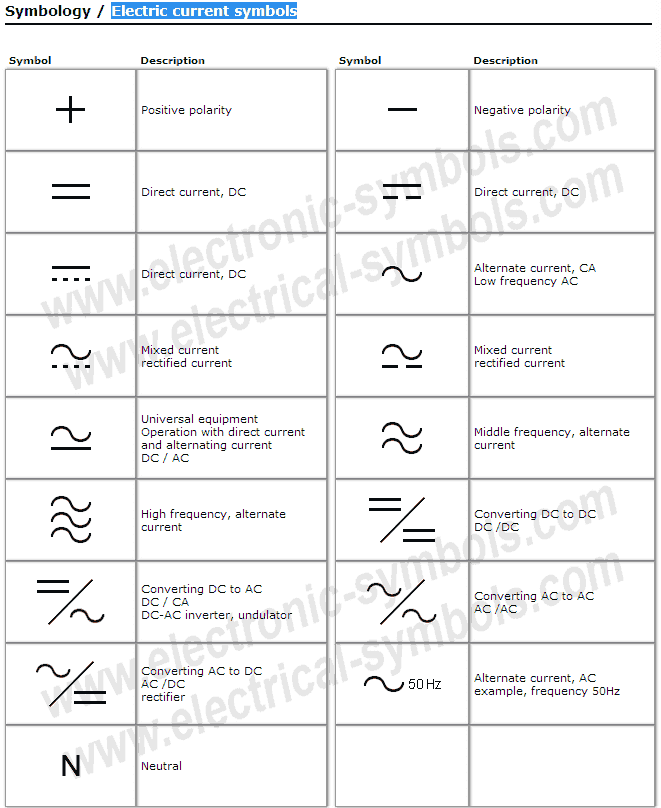Understanding DC and AC Voltage Symbols
Have you ever noticed those squiggly lines and dashed lines next to voltage readings on electronic devices? These aren't just random decorations; they represent fundamental differences in how electricity flows. This exploration delves into the meanings behind these symbols, representing direct current (DC) voltage and alternating current (AC) voltage.
Understanding these symbols is crucial for anyone working with electronics, from seasoned engineers to curious hobbyists. They provide a visual shorthand for identifying the type of electrical current involved, a critical distinction that affects how circuits are designed, built, and operated. Misinterpreting these symbols can lead to faulty connections, damaged equipment, or even safety hazards.
The DC voltage symbol, often represented as a single solid line with a dashed line beneath it, indicates a constant flow of electrical charge in one direction. Think of a battery powering a flashlight – the current flows steadily from the positive to the negative terminal. AC voltage, on the other hand, is symbolized by a wavy line. This reflects the constantly changing direction of the current flow, as seen in the electricity supplied to our homes.
The choice between AC and DC voltage depends on the specific application. DC is typically used in battery-powered devices and electronics, while AC is the standard for power transmission over long distances. This is because AC voltage can be easily transformed to higher or lower levels, minimizing power loss during transmission. The symbols for DC and AC voltage allow us to quickly and easily distinguish these two fundamental forms of electrical power.
Delving into the history of these symbols reveals a gradual evolution driven by the need for clear communication in the burgeoning field of electrical engineering. While the precise origins remain somewhat obscure, the symbols likely emerged as intuitive representations of the underlying electrical phenomena. The straight line of the DC symbol reflects the unidirectional current flow, while the sinusoidal wave of the AC symbol captures the oscillating nature of alternating current.
The importance of correctly interpreting DC and AC voltage symbols cannot be overstated. Imagine plugging a DC device into an AC outlet – the mismatch in current types can lead to irreparable damage. These symbols act as a universal language, ensuring compatibility and preventing potentially disastrous consequences.
The DC voltage symbol, a straight line above a dashed line, signifies a constant voltage level. The AC voltage symbol, a sinusoidal wave, indicates a voltage that fluctuates cyclically. A simple example of a DC voltage source is a battery, while a household wall socket provides an AC voltage.
One benefit of using these symbols is clarity. They provide a quick and easy way to identify the type of voltage present in a circuit. Another benefit is safety. By correctly interpreting these symbols, we can prevent potentially hazardous connections. Lastly, they facilitate efficient communication among engineers and technicians, ensuring everyone is on the same page.
When working with electrical circuits, always identify the type of voltage present using the appropriate symbol. Ensure that all components and connections are compatible with the designated voltage type. If unsure, consult a qualified electrician or refer to the device's documentation.
Before powering on a circuit, double-check all voltage symbols to ensure they match the power source and connected devices. Verify the voltage ratings of all components and avoid exceeding these limits.
Numerous resources are available for further learning about DC and AC voltage. Online tutorials, textbooks on electrical engineering, and specialized apps can provide in-depth explanations and practical examples.
Advantages and Disadvantages of DC and AC
| DC | AC | |
|---|---|---|
| Advantages | Simple to understand and use, Ideal for battery-powered devices | Efficient for long-distance transmission, Easy voltage transformation |
| Disadvantages | Difficult to transmit over long distances, Limited voltage transformation options | More complex circuitry, Potential safety hazards |
Best practices include careful circuit design, adhering to safety regulations, using appropriate measuring instruments, regular maintenance, and consulting with experienced professionals when needed.
Real-world examples include batteries (DC), household outlets (AC), solar panels (DC), power grids (AC), and electric vehicles (both DC and AC).
Challenges in working with voltage include voltage fluctuations, power losses, electromagnetic interference, safety hazards, and component failures. Solutions involve proper grounding, surge protection, shielding, and regular inspections.
FAQs about DC and AC voltage often cover topics like safety precautions, voltage conversion, compatibility of devices, and the differences between the two current types. Consult online resources or electrical engineering textbooks for detailed answers.
Always double-check voltage symbols and ratings before making connections. Use appropriate safety equipment and consult with qualified professionals when dealing with complex electrical systems.
In conclusion, understanding the significance of DC and AC voltage symbols is paramount in the world of electronics. These symbols are not merely technical notations; they are essential tools for clear communication, efficient design, and, most importantly, safety. From powering our homes to running our portable devices, the correct interpretation of these symbols ensures the seamless and safe operation of countless electrical systems. By familiarizing ourselves with the meaning and applications of these symbols, we can navigate the electrical landscape with confidence and contribute to a safer and more efficient use of electricity. Continue learning and exploring the fascinating world of electricity, and always prioritize safety in your endeavors.
Tiktok shop vanishing act why your pc screen is empty
The blank page your untapped creative powerhouse
Decoding justin johnsons marital status













